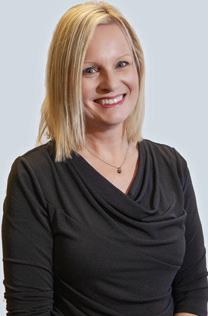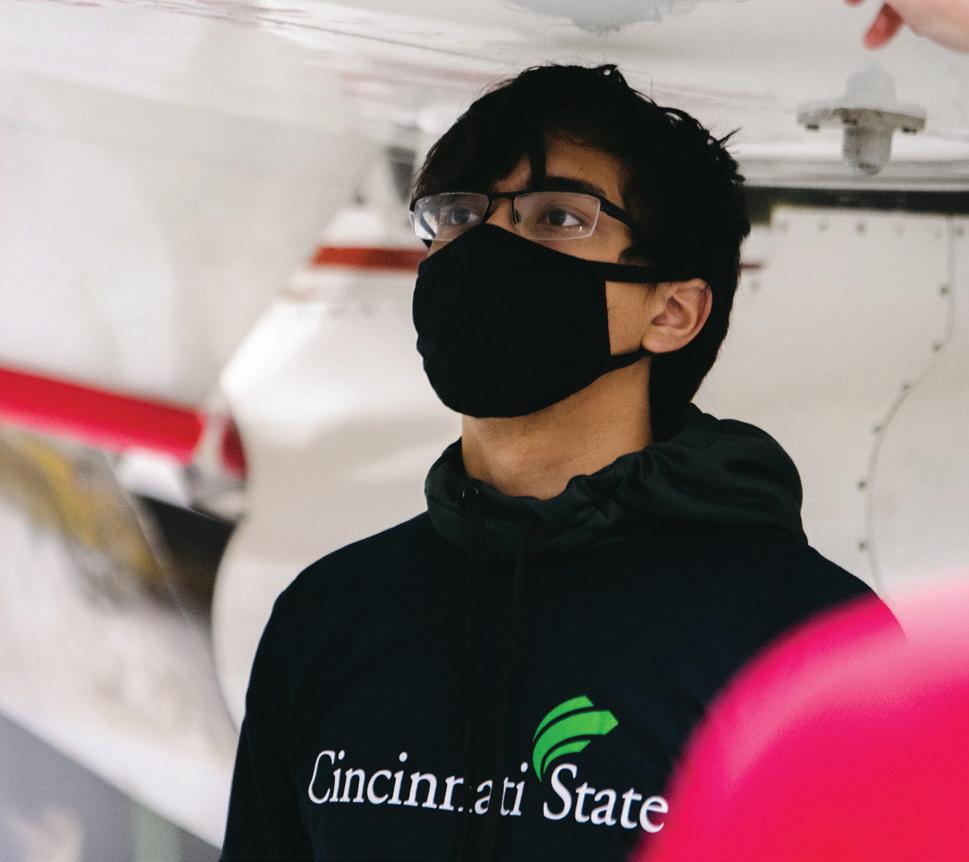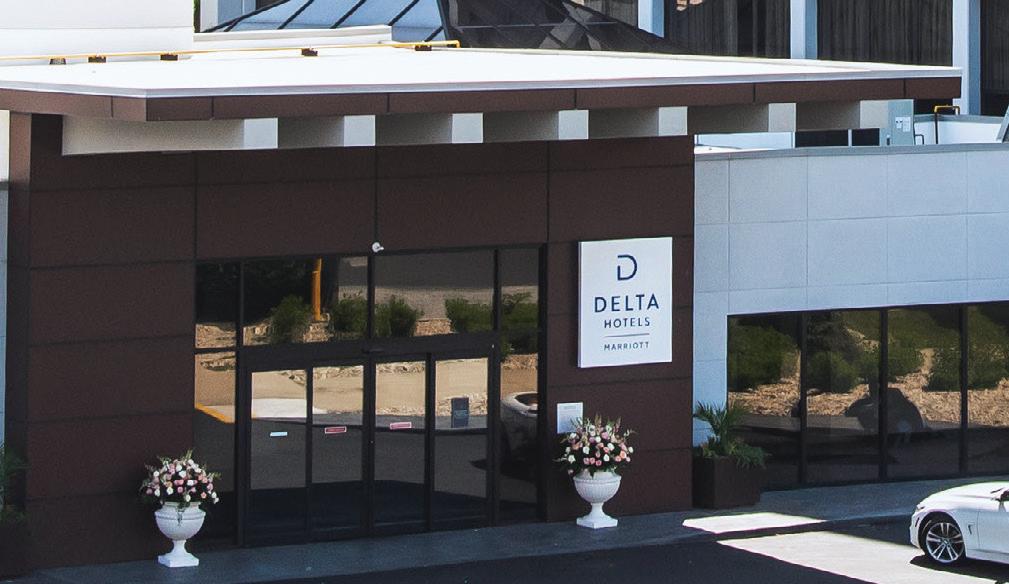MAPPING THE GROWTH
The region announced more than 6,000 new jobs in 2022


The region announced more than 6,000 new jobs in 2022

Whether you’re a start-up or a mid-size company celebrating a landmark anniversary, Heritage Bank can provide the banking solutions and expertise essential to your success. We’re small business banking specialists inspired by our customers’ vision, ingenuity and grit. We’re a community bank vested in the region you call home. We were founded by entrepreneurs. We understand what small businesses need from a bank. • Flexible
Streamlined approvals • Local decision making • Digital banking tools & in-person service • Robust Treasury Management services























Agile, responsive bankers










When you’re ready to bank where you’re a priority, we’re ready to get acquainted. www.OurHeritage.bank

I’m Metro CEO Darryl Haley. If high gas prices are affecting your ability to hire and keep employees, the solution may be as close as the nearest Metro stop.







Riding Metro offers savings, stress relief and convenience compared to driving. And improvements like 24-hour service, new routes and free Wi-Fi and charging ports on all buses means there’s never been a better time to ride.


Find out how Metro can customize a program designed for your company by contacting Ridership Development Director Amy Rasmussen at arasmussen@go-metro.com.







Riding is believing. www.go-metro.com



SPARKING THE FUTURE StartupCincy Week brought together more than 1,000 attendees to OTR.
12 REAL ESTATE
MONTGOMERY’S OWN QUARTER
The new development has popular local businesses and will soon add residential units.

LONDON CALLING British Airways announces a new gateway flight to Europe for June.

The Foundry adds office and nightlife activity across from downtown’s iconic landmark.
12 LEADERSHIP
HR FOR ALL CincySHRM rebrands and expands its human resources assistance to all executive seats and suites.
04 LETTER FROM JILL MEYER 08 BY THE NUMBERS Reviewing trends in employment and consumer prices throughout 2022, plus election results in Kentucky and Ohio. 48 ASK ME ABOUT
Get to know Rebekah Beaulieu of the Taft Museum of Art, Pete Blackshaw of Cintrifuse, and Scott Shively of Bexion Pharmaceuticals.
50 PHOTO ESSAY:
THE RETURN OF BLINK
Artists from around the world and across the region drew an estimated 2 million visitors over four nights in October.

CELEBRATING ECONOMIC WINS IN 2022
Expanding local businesses helped the region announce 6,000 new jobs in logistics, aircraft maintenance, indoor farming, and other emerging industries.
BUCKLE DOWN, AND LIFT TOGETHER Employee-owned businesses both large and small explore the benefits of ESOPs.
WHEN 1 + 1 = 3 IN THE NONPROFIT WORLD Nonprofit mergers are increasing service capabilities and cutting costs in challenging economic conditions.
GREG LANDSMAN IS A BIG FAN OF “NORMAL” The region’s new Congressman discusses what he hopes to accomplish for Cincinnati residents and businesses in Washington, D.C.

Happy New Year!



As we go press with this issue, we’ve just received the long-awaited news that the federal government awarded $1.6 billion in grants for the Brent Spence Bridge Corridor Project. Make no mistake: This is a crowning accomplishment for Ohio and Kentucky and an example of how bipartisan business-political partnerships can accomplish the seemingly impossible.

Indeed, the announcement in Covington saw President Joe Biden (D), Governors Andy Beshear (D) and Mike DeWine (R), and Senators Mitch McConnell (R), Sherrod Brown (D), and Rob Portman (R) declare that the project would finally move forward. It was a tremendous day for our region, and one that resulted from the hard work from so many people across the region and across the political spectrum.

The Cincinnati USA Regional Chamber has led the Build Our New Bridge Now effort for more than a decade, working to ensure this critical infrastructure upgrade comes to fruition. We’re so grateful to the dozens of business leaders who have invested time and energy to make this project happen.
The bridge that carries 3 percent of our nation’s GDP and so many of our local residents is about to get a companion to open the economic logjam. In the process, our community will benefit from a $3 billion project creating jobs and economic ripples. And in addition to the growth it will foster, the new bridge will stand as a symbol of what we can do when we work together.
I can’t think of better way to start 2023.




 JILL P. MEYER jill.meyer@cincinnatichamber.com
JILL P. MEYER jill.meyer@cincinnatichamber.com

Hands-on Cooperative Education builds resumes and relationships.
Hiring Co-op students offers valuable educational opportunities to students, and also benefits your business:

• A cost-effective way to fill temporary and long-term staffing needs
• An opportunity to evaluate potential future employees

• Cincy State students are local and they STAY local
• A way to fill entry-level professional positions with qualified candidates
Cincinnati State’s career pathways are based in the workforce needs of this community. Make sure you are getting the talent you need for the future of your business.

LEARN HOW to set-up a Co-op Program at your company or post your position to co-op students and recent graduates visit: www.cincinnatistate.edu/coop

Reserve your stay at the new Delta Hotels Marriott Cincinnati, centrally located right off the intersection of I-275 & I-75. Just 15 minutes north of downtown Cincinnati.









Host conferences in one of our many event rooms with 20,000 square feet of event space configurable to your needs. 513 • 552 • 6369 www.marriott.com/cvgde nidhi@deltahotelscincinnati.com

THE FOUNDRY BRINGS NEW OFFICE AND RESTAURANT LIFE TO FOUNTAIN SQUARE.


Get a jump on news about the upcoming British Airways flight to London, early impressions of the Montgomery Quarter office/retail development, and CincySHRM’s rebranding and relaunch. And catch up on the impact of October’s Startup Cincy Week and how you can still connect with local entrepreneurs.
As 2022 turns to 2023, it’s time to check in on economic trends across the 16-county Cincinnati region. Overall employment has finally rebounded to pre-pandemic levels, though the path back to those numbers has had its ups and downs over the past two years. Recovery has been anything but a steady upward march, thanks in part to high consumer price inflation—though those numbers seem to trending the right way as well. How much did the region’s economic conditions impact the recent mid-term elections? Be your own judge.
You take care of business, we’ll help take care of you.
Wealth management is a demanding job, and you already have one of those. We’ll help grow your personal wealth, so you can focus on growing your business and enjoying life.

Let’s

talk about your future today.
Cintrifuse hosted the sixth StartupCincy Week October 14-18 and brought together more than 1,000 attendees and speakers from across the U.S. representing startups, investors, corporations, universities, and regional growth catalysts. Connections were made via curated networking sessions, workshops, panels, and casual conversations.
THE FUTURE IS NOW Cintrifuse’s Union Hall headquarters in Over-the-Rhine (pictured) served as nerve center for the event, whose theme was “Spark the Future.”
The Alloy Green Room, a Shark Tank-like program focused on sustainable startups, awarded first place to the Cleanup Collective, an idea that originated from Cintrifuse’s and the City of Cincinnati’s Rethink Litter Hack-a-thon. The startup is working with the Cincinnati Parks Foundation to see how it can improve litter conditions in local communities.
StartupCincy Week was a collaboration with Alloy Development, Blue North, CincyTech, ECDI, Endeavor, Flywheel Social Enterprise Hub, Product Refinery, REDI Cincinnati, and Reversed Out Creative. Many attendees stayed in town to see thecreative collaboration at BLINK.
For those who didn’t attend the week’s events, and even for those who did, Cintrifuse has collected videos and presentations in an online library at startupcincy.com. That’s also home for the GreenCharge digital library of local sustainability resources and events.


The new development is attracting popular local businesses and will soon add residential tenants.

–SARAH M. MULLINS
The city of Montgomery is nearing completion on the $150 million mixed-use Montgomery Quarter development that provides retail and accommodation space right off of Ronald Reagan Highway at the newly constructed roundabout on Montgomery Road. Brandicorp and Neyer Construction partnered to build office and retail buildings spanning 22 acres, breaking it up into three phases. Tenants include Fifth Third Private Bank, the Latin-inspired restaurant Livery, a Bru Burger restaurant, the ramen and sushi restaurant Kozue, The Rambler boutique hotel, and men’s clothing store Hellman’s.
“The development has been a vision of the city council and staff for many years and will serve as a spectacular gateway into the city,” says City Manager Brian Riblet. “It complements historic Montgomery, provides vitality to the area, and will enhance the entire community for current and future residents, businesses, and visitors.” In addition to commercial space, apartments are currently under construction. A total of 148 units will span two buildings of flats and two buildings of townhomes; they’re slated
for completion in the summer.
Some of Montgomery Quarter’s first tenants have already opened, including Hellman’s. Owner Chuck Hellman decided to rebrand the former Blaine’s Fine Men’s Apparel in Olde Montgomery and move the clothing store to the new development. Hellman’s is known for dressing prominent athletes, celebrities, and local businessmen and has millions of fans following along on TikTok, where the store shares outfit inspiration. Hellman says the new development, with its prominent location and plenty of parking, was one of the main reasons he decided to move and rebrand. “We get a lot of local business at the Montgomery Quarter store,” he says. “We’ll pull from Columbus, Dayton, Chicago, Detroit, and locally, predominantly Indian Hill, Loveland, and Sycamore.”
Hellman also owns Hellman Clothiers in Carew Tower downtown, where shoppers find
funkier, fashion-forward collections. Opening a second location was an investment that he says is exceeding his expectations, with the prime new development bringing in lots of foot traffic already. “People are really finding the store, and business is quite good. I can’t say enough good things and couldn’t be happier.”
Riblet says as more businesses open in the Quarter, traffic will increase not only at Montgomery Quarter but in the nearby Olde Montgomery business district. “The city has received positive community support for the project as well as the sense that it will complement the restaurants and small businesses already in historic Montgomery,” he says. “New housing options will draw visitors to the area, and the public space creates engagement and entertainment opportunities.” Additional tenants are slated to open in early and mid-2023, along with new tenant announcements coming soon.
“Business is quite good. I can’t say enough good things and couldn’t be happier.”

Products issued by The Ohio National Life Insurance Company and Ohio National Life Assurance Corporation. Guarantees are based on the claims-paying ability of the company. Products, product features and rider availability vary by state. Issuer/Issuers not licensed to conduct business in NY.
One Financial Way | Cincinnati, OH 45242 | 513.794.6100 | ohionational.com

flight to Europe starting in June. —SARAH
M. MULLINSThe Cincinnati/Northern Kentucky International Airport (CVG) is introducing a nonstop British Airways flight this summer between Cincinnati and London Heathrow, creating opportunities for both business and leisure travel across the region. A direct flight to London was consistently one of the most in-demand routes here, according to airport CEO Candace McGraw, and the new partnership with British Airways (the 14th airline serving CVG) helps increase passenger carrier options, a key goal of hers. “By offering diversified passenger carriers, once you have carrier choice it leads to overall low fares,” says McGraw. “We’ve had the lowest airfare among comparable airports for four or five years running.”
CVG is offering incentives to airlines such as marketing support and fee waivers to encourage them to offer additional flight options out of Cincinnati. The airport has been actively looking to obtain this new transatlantic link since 2018, says McGraw; it will join Delta’s Paris flight as the only nonstop options to Europe from here.
CVG is the seventh largest cargo airport in North America, with a total annual impact of $6.8 billion on the local economy, and the London flight will add to the existing economic boost. CVG put together a business case that included passenger demand data from within the airport’s two-hour radius and conducted an economic impact study based on five departures a week. “Based on annual visitor spending, airline spending, parking, and concessions, the economic impact of this new route will be $57.5 million per year,” says McGraw. “This flight gives greater connectivity for leisure and business to the UK and hundreds of markets beyond London.”
In addition to passenger service, British Airways and DHL agreed to a cargo partnership that could alleviate concerns about a possible slow passenger revenue uptake. With more cargo in the belly of a plane, not as many seats need to be filled in order for the flight to be profitable, says McGraw.
Direct service to London also serves as a hub for connections from Heathrow to 148 other airports around the world, opening the door for attracting businesses to Cincinnati that need easy access to the UK and beyond. McGraw says several companies in this region already send employees to London on a monthly basis, and businesses looking for a presence in both Cincinnati and the UK now have an incentive to relocate here. CVG regularly works with economic development experts at REDI, Northern Kentucky Tri-ED, and VisitCincy to add in-demand flight options that will help entice businesses and talent recruiting to the region.
The British Airways flight joins other new nonstop options at CVG like Breeze’s service to Charleston, Providence, Orange County (California), and San Francisco, which is scheduled to launch in the first quarter. London tickets currently are on sale with introductory round-trip fares starting at $665.



The
Fountain Square’s status as a downtown landmark is being elevated by The Foundry, the new 3CDC development bringing additional talent, business connections, and nightlife options to a gathering spot where more than two million people already cross paths annually. The visibility and high traffic volume helped attract Divisions Maintenance Group, Deloitte, Turner Construction, and Jeff Ruby’s Steakhouse to relocate to the former Macy’s department store. The $60.5-million mixed-used project rebuilt the three-story building from the ground up with a sleek, modern design and floor-to-ceiling windows and now has 150,000 square feet of office space and 35,000 square feet of street-level retail and restaurant space.
Jeff Ruby’s Steakhouse and Royce, a newto-market French brasserie, opened in the fall to cater to business clientele and downtown residents and visitors alike. “We’ve always been hometown-proud, and moving closer to the city’s center helps take that connection to the next level,” says Britney Ruby Miller, CEO of Jeff Ruby Culinary. “With people coming back
downtown to work, play, and live, this is a prime time to be in the midst of it all. Moving to a much larger space directly across from the iconic center of the city at Fountain Square was a bit of a dream. There’s a buzz there we haven’t seen in a few years.”

Relocated from its longtime home at Seventh and Walnut streets, the restaurant offers the classic Jeff Ruby experience along with new private spaces and more capacity, plus a sushi bar and enhanced live entertainment on an elevated stage.
Divisions Maintenance Group, which provides businesses with maintenance services through a network of technicians, is taking 103,000 square feet of office space over two full floors. A combination of outgrowing their separate existing offices— expanding from 500 employees to 800 in the last few years—and the need to attract top tal-
ent were chief reasons the company chose The Foundry, says General Counsel Alex Strohm.
The new office space is functional with huddle rooms, conference areas, and individual offices to cater to everyone’s working style, he says, while a cafeteria, cafe, and game room help make it a desirable place to work in person. “We wanted a place for everyone,” says Strohm. “The Foundry checked all of our boxes: It’s an iconic building on Fountain Square, the epicenter of Cincinnati’s business community offering the right mix of amenities, visibility, opportunities for community engagement, resources, and entertainment.”
Strohm says that Divisions will continue its organic growth in 2023 by working to attract the best developers, programmers, and tech talent in the region, and the new downtown headquarters space will be an exciting draw for new employees and existing staff alike. The company plans to complete its move by mid-year.
Deloitte and Turner Construction took occupancy of their office spaces in mid-2022. Five Iron Golf, which features golf simulators, instructors, club fitting, and a bar space, is scheduled to open in the first quarter.
“It’s an iconic building on Fountain Square, the epicenter of Cincinnati’s business community.”






















Thank you to our partners who are investing in the Build + Elevate NKY economic growth plan! They are enabling the economic transformation of Northern Kentucky to 2026 and beyond.














As a national organization, Society for Human Resources Management (SHRM) is the authority on all-things HR. It offers an arsenal of e-library research and resources, hosts sophisticated conferences, and manages the industry’s leading certification programs: SHRM Certified Professional (SHRM-CP) and SHRM Senior Certified Professional (SHRM-SCP).
On a local level, CincySHRM boasts a personality all its own. Formerly known as GCHRA, it extends the parent organization’s capacity with a relational twist. “It’s much more about networking and relationship-building,” says CincySHRM President Karen Brandenburg, who has been a member since 2000.
Her employment at Custom Built Crates, a family-owned company with limited in-house HR resources, means her two-decade membership with CincySHRM has allowed access to sophisticated data and compensation tools that would otherwise be out of reach. It’s also given her—and other small-company managers—a much-needed sense of community. Brandenburg explains that many HR employees of small- and mid-sized companies lack the luxury of “walking down the hallway to talk about what’s going on” on an HR-related issue, as a larger company might provide. Connections within CincySHRM provide that “hallway-like” comradery.
With CincySHRM’s recent rebrand came fresh efforts to attract non-HR professionals into the organization. That’s right: CincySHRM members needn’t have a title in HR to get involved. In fact, the diversity is encouraged. “We’re all in the people business,” Brandenburg says of the common thread that unites all professionals who perform HR-related duties, including those in the C-suite.


For smaller organizations, in particular, where employees wear many hats and may dip into HR roles by default, CincySHRM’s resources can be a powerful tool. From the broad-interest topics at monthly Connect and Learn meetings and bi-monthly presentations on legal and talent acquisition trends to certification prep courses, how-to programming, and a special group for “emerging” HR professionals (notice it isn’t just “young” professionals, as many people choose HR as a second career), there are plenty of avenues for members to choose their own adventure. But arguably the biggest value comes—fittingly—in the simple connection with other humans. “It’s getting to know people that do the same work as you and having a network of people to reach out to when you need help,” says Brandenburg.



Founded in 1935 and now a “mega” affiliate with approximately 500 members, CincySHRM is one of the nation’s oldest affiliates and has thus “been woven into the fabric of our greatest companies here in the region,” says Dan Netter, an employee of Aquarius Professional Staffing who assumes the group presidency in January 2023. “Our HR community is one of the most welcoming and open collections of people I’ve ever found in the Greater Cincinnati region.”




A joint partnership between Cincinnati Magazine and the Cincinnati USA Regional Chamber, Realm is a quarterly print publication designed to connect area executives with each other and with news, resources, and opportunities designed to help them succeed. Reserve your space today.







TO ADVERTISE: advertise@cincinnatimagazine.com













Entrepreneur Tarek Kamil has a simple rule of thumb for success with a startup business: Do not die.
More than 20 years ago, he launched WhatIf Sports, an online fantasy sports game that grew out of a hobby. He sold it to Fox Interactive in 2005. Years later, as a member of the Madeira school board, he developed a communication platform to help parents and educators better engage with students. That evolved into a product called Broadcast, the main offering of his latest company, Cerkl. “It was never meant to be a business,” says Kamil. “I built it in my free time.”
What started as a pastime has grown rapidly, and now large companies subscribe to the Broadcast platform as a means for more effectively communicating with employees. Cerkl started with Kamil as the lone employee; it didn’t die, and now it employs about 50 people. At the start of 2022, the company announced plans to add another 125 jobs, representing a total of $9.45 million in payroll, over three years.
That major expansion of the Blue Ash-based startup was the Cincinnati region’s first big job growth announcement in a year that saw homegrown businesses make plans to add thousands of new jobs supported by tens of millions of dollars in investments. In fact, businesses announced plans to add nearly 6,000 jobs in the 16-county tristate region, according to REDI Cincinnati and Northern Kentucky Tri-ED, the area’s two main economic development organizations. “It’s definitely been a banner year,” says REDI Cincinnati CEO Kimm Lauterbach.

The year ended with the biggest announcement in all of 2022, a plan revealed in late December by Medpace to add 1,500 employees and $90 million in payroll over six years at its headquarters campus in Madisonville. The growing company provides clinical research to pharmaceutical companies developing new drugs and now has operations in 40 countries. The company said it plans to hire for a variety of roles in Cincinnati, including physicians, lab technicians, clinical research associates, data analysts, financial analysts, and software engineers.
Medpace also said it’s committing to invest $150 million to expand its Cincinnati headquarters by constructing a new building expected to hold 250,000 square feet of office space along with a parking garage for 1,000 vehicles. The infrastructure investment will allow Medpace to grow its employment in Ohio by nearly 80 percent, the company says.
The health care and life sciences sector has been a significant factor in the region’s job growth in recent years. From 2017 to 2021, the region saw nearly 25 percent growth in jobs in the biohealth sector, says Lauterbach. “We’ve proven that this is a growing place for the life sciences industry, and that’s really impactful for us.”
A total of 2,356 new jobs in Northern Kentucky were announced in 2022, says Tri-ED CEO Lee Crume, and they’ll pay an average wage of just over $66,000. Those new projects reflect nearly $300 million in capital investment. All of those metrics exceeded Tri-ED’s goals for the year.
The year continued the growth in the local economy that began in the latter half of 2020 and continued in 2021. “We came into the year with a
lot of momentum, with good results having been posted, and with a good project pipeline,” says Crume.
IN NORTHERN KENTUCKY, 2022 began with the announcement that 80 Acres—the Hamilton, Ohio-based indoor fruit and vegetable growing operation—plans to open an under-roof, vertical farming facility in Boone County that could eventually employ 125 people. The operation will be a high-tech, controlled-environment vertical farm to host the harvesting, packaging, and distributing of leafy greens, microgreens, berries, and tomatoes. It will have the capacity to grow millions of servings of local, fresh produce for the region. “This farm is the biggest step forward for us yet, more than doubling our total production, and growing our footprint outside Ohio,” says 80 Acres CEO Mike Zelkind.
For the most part, new investments and job growth in the region came from companies such as Medpace, Cerkl, and 80 Acres, enterprises already located here that decided to stay and expand. There may be no better example of that than Total Quality Logistics, which launched in 1997 and has grown into an $8 billion operation that employs 9,000 people in 56 locations across the U.S.
In March, TQL announced its third expansion since 2019 at its Clermont County headquarters. The freight brokerage company connects its customers (manufacturers that have products to ship and distribute) with freight carriers across the country who can do the job. Already growing steadily since its founding, business exploded in 2021 with the

pandemic-fueled increase in e-commerce. Its employee headcount grew 49 percent in 2021 alone.
The company revealed plans in March to add another 1,000 jobs at its headquarters, amounting to an estimated $60 million increase in its annual payroll. In addition to new jobs, TQL said it plans to substantially expand its real estate footprint with an $18 million investment at its Ivy Pointe headquarters campus in Clermont County’s Union Township. “They just continue to knock it out of the park in terms of their growth and their success,” says Lauterbach.
Enable Injections is anoth-
FEAM Aero President Cam Murphy (left at podium) and Gov. Andy Beshear (below) helped announce new Northern Kentucky expansions in 2022.


er homegrown company, a life sciences startup that began its life in 2010 as a portfolio company of CincyTech, the public-private venture investor. Enable is developing wearable drug delivery systems for a range of therapies and diseases, devices meant to reduce the need for intravenous drug administration. In March, it committed to adding 257 jobs over the next five years, with an estimated additional payroll of $19.9 million.
“That’s a critical example of finding that unicorn startup that the Cincinnati region embraced,” says Lauterbach. “We feel it cements the Cincinnati region as their forever home, hopefully, and is another great example of how we’re working from startup all the way to scale at these technology companies.”
The acquisition of a local company can often mean the closure or relocation of the home office. In May 2021, American Financial Group’s life insurance unit, Great American Life Insurance, was acquired by Massachusetts Mutual Life Insurance Co. in a $3.5 billion deal. The 600 employees of Great American Life may have worried about their future, but in March MassMutual committed to not only preserving those 600 here but adding 150 jobs by the end of 2026.
The Springfield, Mass.-based financial company also said it would invest $8 million to build out office space in the GE Global Operations Center at The Banks and move most of the former Great American workers there. The Great American Life brand will be changed to MassMutual Ascend, a name that may soon become more familiar as it’s expected to be affixed to
the exterior of the 12-story GE Center.
The expansion of an office project in the central business district was good news in the new pandemic reality of remote and hybrid work, Lauterbach says. “That’s a testimony to the diversity of our economy.”

Ohio in 2022.
The region’s economic vibrancy was also endorsed in November when British Airways announced it would begin a new direct route from CVG to London Heathrow beginning in summer 2023. It will be the second direct flight from Cincinnati to Europe, after Delta’s nonstop to Paris. (Read more about British Airways’ plans on page 16.)
“This announcement puts us on stage to recruit companies that we wouldn’t have had conversations with,” says Lauterbach. “It’s definitely a validation of the market.”
For Kamil and his Cerkl startup, Cincinnati’s regional economy was the only one to consider when it came to time to expand. “I will never leave,” he says. “There’s no reason for us to go anywhere else.”

One of his biggest reasons for staying here is the relatively low cost of doing business. Another is the supply of tech talent, not just from the University of Cincinnati but from other colleges in the broader region such as Ohio State, the University of Dayton, and Purdue University, all with reputable engineering schools. “There’s so much talent here that people don’t talk about,” says Kamil.
Then there is the number of big companies in Ohio: 25 companies on the Fortune 500, ranging from Kroger and Procter & Gamble to Progressive Insurance and Goodyear. They each employ tens of thousands of people, making them prime candidates for Cerkl’s
internal employee communications platform.
Kamil also notes the region’s “Midwest mentality” as a plus in making business connections. “It’s easy to get introduced to the right people,” he says. “I don’t think there’s anywhere better in the world to create business-to-business software.”
Many startups fizzle before they can figure out the right product fit for the right markets, he says, partly due to the expense of doing business. That risk is lower here due to
manageable costs, strong talent, and big companies. “When you’re building a business, the number one key to success is Do not die,” says Kamil. “People assume startups just explode. But that’s not in line with reality. The reality is Do not die. When you find your product fit, that’s when it’s time to accelerate.”
The past year was focused on sales and marketing and renewing customers, he says, and over the next six months he expects Cerkl to reach revenue milestones that will trigger the new hiring he’s planning.

ECONOMIC NEWS IN Ohio was dominated by the announcements of two major projects in 2022. In January, Intel unveiled plans to invest more than $20 billion to build two semiconductor factories in Licking County, a project that’s expected to create 3,000 Intel jobs and support 7,000 construction jobs. And in October, Honda announced plans to build an electric vehicle battery plant in Fayette County, a $4 billion project expected to create 2,200 jobs.
Those two projects have already provided something of a ripple effect, putting the state on the radar as a center of advanced manufacturing. “Ohio has really skyrocketed on to the hightech map,” says Lauterbach.
The growth of electric vehicle battery manufacturing, in particular, should present opportunities for this region. In Kentucky, Ford is building two lithium-ion battery plants in Hardin County, and Envision AESC, a Nissan joint venture, plans to build
a plant in Bowling Green. “Imagine what that supply chain opportunity looks like from southern Kentucky up through just south of Columbus,” says Lauterbach. “We have a rich automotive history, so I think the opportunity for us is pretty massive for the foreseeable future.”
The evolving dynamics of the nation’s supply chain and this region’s role as a key link in the chain are driving new jobs and investment in Northern Kentucky, too. “It’s been a really strong year in the logistics space and where industries intersect with
logistics,” says Tri-ED’s Crume.
In March, F&E Aircraft Maintenance (FEAM Aero) said it would expand at the Cincinnati/Northern Kentucky International Airport, where it already employs about 300 people. It plans to create nearly 250 full-time positions and invest $40.2 million to build a three-bay hangar, large enough to house Boeing 767 aircraft, to support the airport’s growing cargo operations led by Amazon and DHL. “Those are fantastic, good-paying trade jobs,” says Crume.
The performance-based incentive agreement with the state of Kentucky calls for FEAM to pay an average hourly wage of $38.50, including
“PEOPLE ASSUME STARTUPS JUST EXPLODE. BUT THE REALITY IS WHEN YOU FIND YOUR PRODUCT FIT, THAT’S WHEN IT’S TIME TO ACCELERATE.”
More than 6,000 new jobs in the 16-county tristate region were announced in 2022, ending with the biggest of all in late December: Medpace adding 1,500 employees and $90 million in payroll over six years at its headquarters campus in Madisonville.
“It’s definitely been a banner year,” says REDI Cincinnati CEO Kimm Lauterbach.
This region is in the middle of an emerging high-tech manufacturing corridor from Bowling Green in the south (Nissan’s Envision AESC) to Columbus in the north (Intel, Honda). As a result, “It’s been a really strong year in the space where industries intersect with logistics,” says Northern Kentucky Tri-ED CEO Lee Crume.
FACING SOME UNCERTAINTY
Businesses are facing volatile economic conditions for 2023, including a possible recession, but the low cost of doing business in Cincinnati and Northern Kentucky will remain a benefit through any period of uncertainty.
benefits, to its new workers.
In August, local officials celebrated the opening of Summit Packaging Solutions’ operation in Boone County, the result of an $18.2 million investment the company says will create 254 new jobs. Summit is a major cog in the nation’s supply chain, providing custom packaging for products and brands owned by Fortune 500 companies. It’s a minority-owned business led by Adam Walker, whose resume includes five seasons as an NFL running back in the mid-1990s.
Also in August, Mackenzie and Paige Logistics, which now employs 30 people in Boone County, announced aggressive growth plans to invest nearly $4 million and create 210 full-time jobs over 10 years. The company plans a new headquarters operation in Florence to employ people in sales, operations, administrative, and management roles. During the year, M&P Logistics made the Inc. 5000 list of the fastest-growing companies in the country, with 84 percent growth over three years.
Another fast-growing logistics firm, BM2 Freight Services, said in September it will expand its offices in Tower One of Covington’s RiverCenter complex with a $2.3 million investment that’s expected to lead to 56 additional jobs.
In addition to the rapid growth at its Clermont County headquarters, freight broker TQL is growing in Kentucky as well. It announced plans in February to add 525 jobs over 10 years in the commonwealth, including 125 at its operation in Boone County.
New Northern Kentucky projects included the plans of life sciences company Thermo Fisher Scientific to create 200 full-time jobs as part of a $59 million expansion of the company’s clinical research lab in Highland Heights. Nearly 650 people are already employed at the site, where they handle clinical testing of pharmaceuticals.
Also in the life sciences sector, the Kentucky General Assembly agreed to direct $15 million to the creation of a shared research and development lab proposed by several Covington-based biotech companies. Bexion Pharma-
ceuticals, Gravity Diagnostics, and CTI Clinical Trial and Consulting Services say it will accelerate their own growth and the growth of the industry overall in Northern Kentucky. “That’s a fantastic economic development win for the community,” says Crume.
THE BOONE COUNTY expansion for 80 Acres comes from a company that’s combined agriculture and high-tech, growing fruits, vegetables, and herbs indoors in controlled environments
“WE HAVE MORE THAN $2 BILLION WORTH OF CAPITAL INVESTMENT PROJECTS IN OUR PIPELINE, BUT WE’RE HEARING COMPANIES SAY, W E ’ R E G O I N G T O J U ST H O L D O N WE’RE GOING TO JUST HOLD ON T H I S D E C I S I O N ( F O R N OW ) THIS DECISION (FOR NOW) .”
that require less water than outdoors and aren’t susceptible to the whims of Midwest weather. It built its first indoor farm inside the old Miami Motor Car Co. building in Hamilton, Ohio, beginning operations there in 2021.
The business has been operating at capacity, with packaged mixes of greens and cherry tomatoes sold in Kroger and Whole Foods stores and carried by major food distributors. When it looked to expand outside of Ohio, it settled on a site in Florence, an existing building that was once the home of a printing plant. “We grow to meet demand,” says Tim Dwyer, vice president of engineering and real estate for 80 Acres. “We’re trying to expand responsibly, and we thought the Northern Kentucky area would be a great place for us. It’s about an hour from our headquarters, and it will allow us to push south into other markets.”
The Florence farm will put the company’s produce closer to consumers in Lexington and Louisville, and at 200,000 square feet it will ultimately be nearly three times the size of the Hamilton farm. 80 Acres products are available across Ohio, Indiana, and Kentucky, and the company recently entered the Nashville market.

Part of its sustainability philosophy is to adapt existing facilities for reuse when possible. The Florence facility fit the bill in terms of its footprint, the ability to reconfigure the interior as needed, and its existing utility infrastructure, Dwyer says. The good fit was fortunate, as the cost of building new was rising and the prospect of supply shortages meant the possibility of construction being delayed. “This building very quickly started to check all the boxes we needed,” says Dwyer. “This farm is going to be much, much larger and will include all of our learnings from the original farm. It’s also
going to include all of the R&D that we’ve been working on over the last two years.”
The farm’s first zone is in operation now, growing basil. The next zones will grow leafy greens. The farm is being built out in modular fashion, with each zone able to be adapted to different plants by changing the lighting and the climate, says Dwyer.
The region’s 2022 job wins provide momentum going into a year that economic development experts say will be hard to predict. Rising interest rates, the volatility of energy costs, and a war in Europe loom as the big intangibles in the economic period ahead. “There are lots of moving pieces that make it hard to predict what the next six to nine months will look like,” says Crume.
Chief among those is the Federal Reserve’s ongoing interest rate increases. “You’re seeing people trying to make deals work with much higher interest rates than we’ve seen in recent times,” he says. “Things are just moving slower as a result.”
Lauterbach says she’s seeing the same effect. “We have more than $2 billion worth of capital investment projects in our pipeline, but we’re hearing companies say, We’re going to just hold on this decision and give ourselves six months, eight months. We want to see where we’re going to end up in this economic environment.”
As Cerkl’s Kamil notes, the low cost of doing business in the Cincinnati and Northern Kentucky region will remain a benefit through any period of uncertainty. “We have a really affordable location,” says Lauterbach. “So as companies are looking at costs rising all over, we’re going to have a more affordable option here in the Midwest. I think that continues to give us an advantage.”
Business recruitment and retention efforts were led by REDI CEO Kimm Lauterbach and Northern Kentucky Tri-ED CEO Lee Crume.



It was the end of a wonderful three days and two nights in Nashville. Ingage Consulting’s employees were in a celebratory mood, chatting excitedly about the successes 2017 had brought and the new clients who’d come their way. They bonded over bourbon and blues and shared family photos and company gossip. Now, digesting both a view of the Nashville skyline through the restaurant windows and the Southern buffet dinner, 55 employees and
THE TOP EXECUTIVES AT INGAGE PARTNERS ARE HAPPY WITH THE RESULTS OF THEIR ESOP. BILLABLE HOURS, UTILIZATION, AND PROFITS ARE UP. EMPLOYEES ARE MORE ENGAGED, TESTING IDEAS AND WORKING HARDER.
precise verbiage he used. But he vividly remembers the reaction. “The room went silent. Totally quiet. It was like, Uh,what? Is that a good thing?”
The stunned quiet, followed by a torrent of questions and a dose of misunderstanding, isn’t surprising, says David Whaley, a partner at Thompson Hine and a leading expert on employee stock option plans (ESOP). Almost by necessity, he says, business owners need to work surreptitiously with the many parties to the transaction—bankers, lawyers, trustees, third-party administrators, and themselves—before letting employees in on the secret. Owners need the flexibility to work at their own speed in setting up an ESOP or, if the shoe doesn’t fit, the ability to quietly pull the plug.
Among the Cincinnati region’s employee-owned companies are Model Group, Messer Construction, School Outfitters, Rhinegeist, Ingage Partners, The Motz Group, Epipheo, and commercial real estate developer Al. Neyer.
“I believe our ESOP program creates a culture where there is a great deal of accountability, empowerment, and autonomy with each employee,” says Molly North, CEO of Al. Neyer. “Those kind of attributes can exist in every culture, but family-owned businesses often struggle achieving that. You can make a good business case for a decision, but if the owner doesn’t want to do what makes sense, well, it doesn’t happen. As employee-owners, we take ownership because we actually own the business.”
their spouses sat back as company co-founders Michael Kroeger and Kelly Dolan took the podium.
Kroeger and Dolan were excited to share the results of their under-the-radar work. The news, they believed, wouldn’t just transform their company—it would be a boon to their employees’ futures. Kroeger studied the faces of his employees, anticipating their excitement. “Kelly and I have decided to sell the company, and we’re selling it to you,” he said, or something to that effect. He doesn’t remember the
ESOPs are qualified benefit plans that give employees ownership interest in their company through the issuance of stock. A trust fund holds and distributes these shares, which vest after a certain number of years, while a third-party trustee determines the share price and thus the value of each employee’s holding. Like any stock, the price can go up or down depending on how the company is performing. In essence, ESOPs more closely tie the employee’s financial well-being to the company’s bottom line.
ACCORDING TO THE NAtional Center for Employee Ownership, there are nearly 6,500 ESOPs in the U.S. today, covering more than 14 million employees. The largest is Florida-based Publix Supermarkets (with 230,000 employee-owners), while the Davey Tree Expert Company in Kent is Ohio’s largest with 11,350 employee-owners.
North, who has been with the company since 2007 and led it since 2015, refers to Al. Neyer as a “collective business” and believes employee ownership has changed the mentality of its 190-person workforce. Employee-owners, she says, view clients as not just the company’s but theirs, too. Their work, she says, reflects that personal touch, which customers notice. “When we drive this philosophy,” she says, “we win every time.”
Al. Neyer’s ESOP program began in 2014 when North was the company’s chief financial officer. Like Kroeger, she recalls that employees at first didn’t know what being an employee-owner meant, and so the transition was challenging. After all, the company had been in business since 1894 and was being led by the Neyer family’s fifth generation. Al. Neyer without Neyers as owners seemed unthinkable. “When you’ve worked for years for a family-owned company, you knew who you worked for,” says North, “so it required a culture change and, in effect, a rebuilding of the company.” She sighs.
“I know that now in hindsight.”
Companies decide to adopt an employee-ownership structure for a variety of reasons, says Whaley, but the rationale behind Al. Neyer’s decision is typical. A family business hits a generational wall. Baby Boomer owners are reaching retirement age, and the pandemic has accelerated their itch to move on. But their children have other interests or perhaps already other careers and aren’t keen on keeping the business in the family. “You want out, but what’s your exit strategy?” Whaley says. “You could sell to a competitor or maybe to a private equity group or maybe even to your executive team. That last choice might be preferable because you know them, but they probably don’t have enough cash.”
Family-business owners typically have a strong sense of community, which can be both geographic and personal. For the current owner, for instance, it’s always been his grandfather’s company. For employees of family-owned businesses, they’ve of-
ten worked there for years alongside the founding family’s children. The owner-employee relationship isn’t necessarily paternalistic, but it often carries emotional ties. Selling the business to employees through an ESOP can protect their jobs, allow them to build equity toward their retirement, and give the seller peace of mind. “It’s important to the seller, usually, that the family name is still on the building when the sale is completed,” says Whaley. “It’s not just vanity. It’s that sense of community they want to still project. I had one guy tell me that if he sold to a competitor he’d have to move out of town.”
That sense of community—maybe it’s really the family legacy—is so strong that Whaley says he’s participated in transactions where the seller agreed to take less than the market price for a sale to his employees.
EPIPHEO WAS IN TROUble. The fledgling creative video services company was
cutting edge when it began producing “explainer videos” back in 2009. Clients flocked to them to cut short videos designed specifically for the internet—many of them animated—that would describe complex issues to employees or customers. “The company culture was very loose,” recalls Daniel Armstrong, Epipheo’s head of design. “We said, Hey, let’s just be good to each other. We didn’t need HR policies. Idealism was through the roof. We were making cool stuff, and you can be an idealist when everything is going great.”
But 10 years later the video production field was crowded with competitors, and Epipheo was struggling. The company owners, who were investors but not active participants, realized their old strategy wasn’t working in the volatile new marketplace. They lured former Chief Operating Officer Lucas Cole back, and he teamed with Armstrong to restructure the company and prepare it to be sold. They had 18 months. “That changed everything for me,” Armstrong recalls. “Once you have a goal like that, the metrics become more focused. There is no hiding behind the inefficiencies we had in our business.”
Epipheo, Armstrong says, had lost its scrappiness and, he had to admit to himself, its joy. While Cole focused on the business, he worked to re-energize the creative side. They made a lot of changes in both operating procedures and personnel, and to their surprise overall expenses went down while
Ingage Consulting is one of nearly 6,500 employee-owned businesses in the U.S. today, covering more than 14 million total employees.

After a year of working through the cumbersome ESOP creation process, Epipheo became fully employee-owned in November 2021.
ANOTHER FAMILY Family-owned businesses can benefit from a new culture of accountability by setting up an ESOP, says Al. Neyer CEO Molly North. “Employee-owners take ownership because we actually own the business.”

Before becoming an ESOP, says Epipheo’s Daniel Armstrong, employees might have looked at new client workload as demanding and stress-creating but with little, if any, direct benefit to them. Now, new clients are the employees’ bread and butter.
IN IT TOGETHER ESOP companies survived the pandemic at a higher rate because the employees are much more of an asset, says attorney David Whaley. Motivation can’t be underestimated when the economic chips are down.
work quantity and quality both improved. And, says Armstrong, Epipheo was once again a fun place to work.
He remembers when Cole found a buyer. The contract was set, and the money was right. As minority owners, both Cole and Armstrong would net a tidy sum. And yet they felt empty. They’d put 18 months of their lives into righting the company, whose valuation had tripled. “Lucas said to me, We’ve spent all this time making this business a place that I love again, and I don’t want to give it up,” says Armstrong. “And I just looked at him and said, Me, too.”
So they scrambled and took out loans, putting their personal assets on the line because, as Armstrong says, “we believed in what this team had done, was doing, and could do.”
The owners were stunned and at first somewhat skeptical, but they agreed to sell Epipheo to Cole and Armstrong in September 2020.
Business continued to increase, and a little over a year later the two owners sold the company to its 46 employees, who of course included them. “It was in the plan all along,” Armstrong says, noting it’s another example of the commitment they have to their employees. That idealism hasn’t gone away; it’s just been monetized.
The ESOP strategy started with the two owners agreeing on the profit they needed to cover the risk they’d personally taken and to create a healthy, sustainable company balance sheet. “We came to that number and agreed that, as soon as we reached it, we’d pull the trigger,” Armstrong recalls. They hit their goal in just six months, but it took another six months to work through what’s a cumbersome ESOP creation process. In November 2021, Epipheo became a 100 percent employee-owned company.
ESOPs, Armstrong says, are particularly well-suited for the creative
content industry. Work matters the most when you know you’re going to receive a direct benefit from it, and that’s particularly inspiring to the creative class. He relates a story from just a few weeks after the ESOP was established when Epipheo landed a large new client. Before the ESOP, he says, employees might look at this new workload as demanding and stress-creating but with little, if any, personal reward. Now, he says, employee-owners view new clients as their bread and butter.
Epipheo’s ESOP journey, Whaley says, is another good example of a company discovering that its unique culture or line of work is compatible with employee ownership. ESOPs don’t fit neatly into all cultures, and some owners have walked away when they’ve figured that out. They aren’t rescue plans, he adds, noting that logic tells you employees won’t be excited and motivated at owning a company that’s failing.
AS IN EPIPHEO’S CASE, Ingage Partners’ genetic code sports an altruism strand of DNA. The East End IT business was founded in 2011 as a “purpose-based company” that, just four months into its existence, began to contribute a portion of profits to local charities. Ingage is a Certified B Corporation, meaning it’s recognized by a respected third-party nonprofit as a company demonstrating high social and environment performance. “We measure success on the triple bottom line: people, planet, and profit,” says Kroeger. So it wasn’t a great leap, he says, to begin the ESOP process in 2017. Like Epipheo, Ingage was in good financial health, and, to the co-founders, sharing the company’s growth was in keeping with the reason both
had left promising jobs to start it. “We liked what we were doing, but we wanted to do it differently,” he remembers. “We wanted to build both a company and a community.”
Kroeger has been happy with the results. Billable hours, utilization, and profits are all up. Employees are more engaged, testing ideas and working harder. Employee churn in the IT industry is around 40 to 45 percent; at Ingage, it’s only 15 percent. Employees want to stay, he says, because they know they can be the masters of their destiny.
“We talk all the time about personal balance sheets and assets and what each person can do to improve the bottom line,” says Kroeger. “Instead of cutting out of work early on a Friday, many of our people say, I’m going to work a full day because I know a 1 percent change in billable utilization has a $90,000 positive impact on the company’s bottom line, and that affects me personally.”
Since converting to employee ownership, Ingage has not only grown its core business but also acquired two other companies and placed them all under a holding company called Revision Collective. The decision to grow and then restructure was made, Kroeger notes, on management’s belief that it would positively affect share price. “So, yes, being an employee-owned company affects our decision-making process,” he says, adding that when he and Dolan make decisions they think about the welfare of 100 other employee-owners and what that decision might mean for them. “I need to be a leader, and the last thing I want to do is go into a meeting and tell them that their shares aren’t worth as much. We need to grow value for all of us.”

Most, if not all, of the questions Ingage employees had back in 2017 have been answered by now, and em-
Cincinnati attorney David Whaley says ESOPs are not rescue plans for struggling businesses.
Employees won’t be excited and motivated owning a company that’s failing.
ployee discomfort over the company’s direction has vanished. Kroeger says the initial wariness has been replaced with enthusiasm and a sense of purpose. He and Dolan aggressively pursue continuous ESOP education and, like Al. Neyer and Epipheo, provide quarterly reports and hold an annual meeting for the shareholding employees. “It took a solid 18 months for all of this to sink in,” Kroeger says with a wry laugh, “but that’s because—and this is my only regret—we really messed up early and were a textbook for how not to communicate this change.”
A recent study by Rutgers University points to the resiliency of employee-owned companies, showing that ESOP companies retained staff through the COVID pandemic three to four times better than traditional-ownership firms. Similarly, while 16 percent of the workforce at majority ESOP companies saw their hours cut during the pandemic, 25 percent of non-ESOP employees had hours cut. Pay was better for ESOP companies as well: The report says 27 percent of ESOP company employees saw their pay cut compared to 57 percent for non-ESOP companies.
“I’m guessing we won’t see as many ESOPs formed in the next year or so because of inflation or because of fears that we might move into a recession,” Whaley predicts. “But I expect to see existing ESOP companies survive these pressures at a higher rate because the employees are much more of an asset.” Motivation, Whaley insists, can’t be underestimated when the economic chips are down.
“They are more likely to work as a team to buckle down and not just survive but be ready to thrive when times are better,” he says. “They understand they need to lift together as a team to make sure the company doesn’t fail. And they’re pretty good at it, too.”




 BY LEYLA SHOKOOHE
BY LEYLA SHOKOOHE
Nonprofits are designed to play the long game, given their mission focus and their unique leadership and tax structure. But consolidations, mergers, and acquisitions—each have different legal implications—increasingly present opportunities for nonprofits to both maximize their bottom line andfurther their mission. There’s been a noticeable uptick in these types of partnerships in the sector over the past decade, including several notable local ones in the last two years.
“The economies of scale you can gain from partnering with other organizations is just a fact, and we knew that,” says John Banchy, CEO of Best Point Educational and Behavioral Health. “We realized we could do something better for our community, better for our clients, and better for our long-term sustainability if we came together.”
As CEO and president of The Children’s Home, Banchy was a key member in the merger between his organization and St. Aloysius, two of the region’s oldest nonprofits, that led to the creation of Best Point in 2021. Banchy and a colleague met with two
leaders of St. Aloysius to begin discussing a potential merger some 15 months earlier for the two human services organizations, which have a combined 347 years of service history in the Cincinnati and Northern Kentucky region.
Both St. Aloysius and The Children’s Home provided mental and behavioral health services for families across the region. The former was founded in 1832, the latter in 1864. After the organizations eventually transitioned away from traditional custodial care provided by orphanages, they turned their attention to serving children in homes, schools, and communities. By joining together as Best Point, the unified organization is better equipped to expand a continuum of service, as Banchy calls it.
Before the merger with St. Aloysius, The Children’s Home had assumed management and staffing of the St. James Childhood Development Center on the West Side. St. James was integrated into CoStars by The Children’s Home, a signature program that continues to be offered under the Best Point umbrella. “Before 2022, we had added more than 200 employees through organic growth,” says Banchy. “We were growing almost exponentially, almost doubling the size of the organization, without any mergers or acquisitions, because the demand for the service was there. With that growth, we saw the need for the services—and that’s still true today. We have more than 1,000 children on a waitlist currently for mental health services.”
The question of how to best meet a growing demand for services was on Easterseals’ CEO Pam Green’s mind as well. Her organization joined with Redwood in summer 2022 to become Easterseals Redwood. Now president and CEO of the combined business, Green had another layer to consider: bridging the gap across state lines,
with Easterseals based in Ohio and Redwood based in Kentucky. “We started a Easterseals CEO Pam Green (left) and Redwood CEO Sharon Fusco brought their nonprofit organizations together in order to better compete against for-profit companies providing similar services. about how we could come together to leverage those services to better complement what happens across the bridges,” says Green.
Easterseals served children and adult clientele and their families living with autism and/or other special needs. Redwood helped children and adults with disabilities through educational, vocational, and therapy services. In recent years, as with other human ser-
vice-oriented organizations, for-profits have entered this specific marketplace, ratcheting up the imperative for nonprofits to operate as efficiently as possible.
“A lot of nonprofits that have provided health and human services for years were in a situation where, both from a philanthropic perspective and a government funding perspective, we don’t have a lot of unrestricted funds to invest in infrastructure,” says Green. “Managed care organizations are starting to deliver some of the same services we do, and for-profit companies have different access to capital that allows them to invest in things like technology. So can we come together
Easterseals CEO Pam Green (left) and Redwood CEO Sharon Fusco brought their nonprofit organizations together in order to better compete against for-profit companies providing similar services.

in a way that accelerates growth and reduces overhead so that we’re better able to compete in a different marketplace in the future?”
Much like The Children’s Home, Easterseals and Green had also overseen another earlier, smaller merger. In 2012, six months into her tenure, she helped facilitate her organization’s merger with Jewish Vocational Services as its then-CEO, Peter Block, headed to retirement. “Peter and I set the tone really quickly that we were getting together because we respect this organization and they do things we think will make us better,” says Green. “It was the same thing with Sharon [Fusco, Redwood CEO] and
me. I think organizations look to leaders, and if we’d come in and said, OK, Redwood, we’re going to do things this way now, it might have been different. But if you pick the right partner, what you want to do is say, How can we together be stronger? and not, We’re going to take you over and change everything about you. I think recognizing the expertise and valuing the expertise of our partner is what has really made this successful on both sides of the river. I think our folks see the potential and are just raring to go.”
EASTERSEALS REDwood today employs 400 staff members to serve more than 7,000 individuals and families per year in the region. Best Point serves more than 18,000 people each year in more than 80 locations across the region, with 600 employees. For Best Point, nothing about solidifying the tangible nuts-and-bolts operation proved as difficult as the intangible: the
workplace culture itself.
“That’s been one of the biggest challenges and learning opportunities, and it has been the single toughest thing we’ve done,” says Banchy. “Organizations have different cultures, we all know that. It’s not rocket science. We’re not trying to launch a satellite to triangulate the earth—we’re trying to help kids who are at risk of hurting themselves or others and give them the best opportunity to be successful in life. When we came together, there were certain people from both teams who understood that we’re going to have to bend and work together for the mission, for the community, and for the sustainability of the organization. They knew we’d all have to work together.”
Understanding the human side of a merger or acquisition, both through clients and staff, is essential for success, according to Newport-based consultant Marta Brockmeyer. She’s facilitated more than 50 such partnerships, as she calls these consolidations,

“BY COMING TOGETHER, WE’VE BEEN ABLE TO HAVE A GREATER IMPACT ON THE COMMUNITY, WE CAN NEGOTIATE WITH INSURANCE PAYERS, AND WE CAN LEARN FROM THE ECONOMIES OF SCALE.”

Best Point Education and Behavioral Health CEO John Banchy (left) says his merged organization has been able to save more than $1 million in its first year of combined budgets, which is being invested in programs to provide a continuum of care (above).
many of which fall under the merger-specific category.
“Fundamentally, a nonprofit merger is not a business transaction,” says Brockmeyer. “It rests on business transactions, but it’s a combination of missions, cultures, and values for the benefit of the clients. I think many people regard it as strictly business, and I will tell you that the mergers I’ve seen in the last few years that were not successful were the ones that focused just on the financial piece and did not pay attention to the culture. The great missing focus in the nonprofit partnership exploration or integration is the lack of attention to the culture, because that’s what makes or breaks it. When the people are not the focus, this won’t
succeed.”
For Easterseals Redwood, understanding and zeroing in on culture was implicit. “When you serve people with disabilities, you understand inclusion in a different way, which readily translates to multiple demographic groups because you see the challenges of isolation,” says Green. “When we came together, we both started from that position of, The world would be better if we valued the talents of all of our citizens. That part really is baked into the culture in our organization. Because Redwood worked with a lot of children and we work with a lot of adults, I would say culturally Redwood is really warm and fuzzy and Easterseals is like, OK, what do you need to do
Human services organizations can often benefit from a merger when competing against for-profit companies. “Our merger accelerated growth and reduced overhead so that we’re better able to compete in a different marketplace,” says Easterseals Redwood CEO Pam Green.
Combining services and eliminating overlap can improve any organization, even two that were more than 150 years old: St. Aloysius and The Children’s Home. Best Point Educational and Behavioral Health, formed from their merger, now serves more than 18,000 people each year with 600 combined employees.
A merger between nonprofits is more than a business transaction, says consultant Marta Brockmeyer, it’s a combination of cultures, missions, and values. “When the people are not the focus, this won’t succeed.”
to succeed at work? It’s been interesting watching our teams come together because each really respects and values the role the other plays in the lives of folks at that particular point in their lives.”
Another organization formed as the result of a merger is the Mutual Dance Theatre and Arts Center, which began its merger process just after the pandemic kicked off in 2020. The combined product of the organizations formerly known as the Mam-Luft Dance Co. and the Contemporary Dance Theater (CDT), Mutual Arts is a rare example of a merger in the arts nonprofit sector.
“Contemporary Dance Theater approached me, our board started talking, and we were like, Yes, we do want to merge. We would be happy to do that ,” says Jeanne Mam-Luft, who formed Mam-Luft Dance Co. and had been a CDT staff member several years before. “We had already been contemplating a name change and actually changed our name before the merger to Mutual Dance Theatre. So we changed our name first and then in the fall of 2021, which would have been CDT’s 50th season, we officially merged and basically Contemporary Dance Theater was merged out of existence. I know it sounds sad, but the torch is being carried on.”
Both Mam-Luft Dance Co. and CDT had focused on contemporary and modern dance, but the former had its own small company of dancers,
whereas CDT, founded by dancer Jefferson James, served as a hosting vessel for other touring dance companies. Mam-Luft the company had moved from location to location, according to founder Mam-Luft, and the time came in late 2019 to put down more permanent roots. They found a building in Hartwell, and shortly thereafter she got the call from CDT.
Now Mutual Arts is headquartered at the Hartwell facility, where its resident company rehearses, and while
also maintaining CDT’s location in College Hill as a hub for adult dance classes. Mutual Arts offers several educational opportunities for children, too, including summer intensive training workshops, recreational dance and art classes, and virtual opportunities, among others. “The reason for a merger is to increase our assets, our resources, and our capacity,” says Mam-Luft. “Doing the merger did all those things.”
FINDING GUIDANCE through the merger process for an arts nonprofit proved
“THE REASON FOR A MERGER IS TO INCREASE OUR ASSETS, OUR RESOURCES, AND OUR CAPACITY. THE ORIGINAL GROUPS WERE MERGED OUT OF EXISTENCE, WHICH SOUNDS SAD, BUT THE TORCH IS BEING CARRIED ON.”
challenging for Mam-Luft. While mergers in the human services sector are far more prominent—as evidenced by both Easterseals Redwood and Best Point’s own mergers—Mam-Luft struggled to find an arts-specific example. “It’s hard to find precedents, especially local precedents,” she says. “It’s hard to find people with that memory still of when things happened. Sometimes it’s hard for us in the arts nonprofit sector to find the resources we need.”
Mam-Luft reached out for assistance to ArtsWave, the local united arts fund that helps fund more than 100 arts organizations in the region, and for guidance to Cincinnati Landmark Productions (CLP), which operates Covedale Center for the Performing Arts, the Warsaw Federal Incline Theatre, and the Cincinnati Young
Consultant Marta Brockmeyer says nonprofit mergers will not be successful if they focus solely on the financial transaction and don’t pay attention to the culture of a merged mission-based organization.

People’s Theatre. In 2017, CLP acquired Madcap Puppets, the touring educational outfit, and created a new education and performance space in Westwood. The year before, ArtsWave absorbed Enjoy the Arts, a small, independent membership program formerly in residence at the Cincinnati Museum Center.
While it can be efficient for nonprofits to merge, especially when there are large funders with lots of ties to organizations that have similar audiences, certain historical and functional facets of the previous stand-alone organizations can become lost. Relying on a tried-and-true merger process is the best way to mitigate any potential fallout. “Difficulty can be alleviated or prevented by doing a very thorough process through the exploration phase,” says Brockmeyer. “Because if the cultural stuff, the history, and the traditions are discussed thoroughly enough, then folks know in advance what is going to occur.”
For every loss in a merger, though, there are plenty of positives. For Best Point, that comes by way of a budget surplus, a positive harbinger for its
continued fiscal health. “We’ve been at this now 11 months,” says Banchy. “We have realized a savings of more than $1 million, but we don’t pay that back to our shareholders because we don’t have shareholders. That money goes directly back into our programs and our people, into our long-term plans. Aligning our missions to have a greater impact in our community was one of the north stars I saw from my chair as we looked at, How do we do this merger? By coming together, we could have a greater impact on the community, we can negotiate with insurance payers, and we can learn from the economies of scale. Everybody has different strengths and weaknesses. We understood we were creating a position by strength by coming together.”
Green concurs, almost verbatim. “Our organizations were both in their strongest financial positions that they’d ever been in,” she says. “So it was kind of interesting that instead of saying, We need to merge because we’re in trouble, it was, We’ve got an opportunity to leverage our resources for growth. If either of us had been in financial crisis, it would have been really different. Coming at it from a position of strength was the absolute right thing for our organizations.”
Running for Congress for the first time in November, Greg Landsman defeated incumbent Steve Chabot, who had represented Ohio’s 1st District for 26 years. Landsman, 46, was serving his second term on Cincinnati City Council, where he was first elected in 2017. Before that, he’d served as executive director of the Strive Partnership, a network that fosters collaboration for student achievement. He led the successful Cincinnati Preschool Promise tax levy campaign that now provides two years of quality preschool to 3- and 4-year-olds in Cincinnati.
Landsman, a Democrat, begins his term in the 118th Congress with his party in the minority in
the House of Representatives by a small margin. We speak with the new congressman about the election, his post-election preparation, and what he expects as his term gets under way.
I got into the race because on January 6, 2021, I thought what Chabot did was disqualifying—to try to overturn a presidential election. It was a bridge too far for me, and it turned out it was

Greg
8, 2022.
a bridge too far for voters. He also happens to be somebody who’s been at the forefront of the anti-choice movement for decades.
So running against a big-lie, anti-choice extremist and making sure everyone understood what was at stake played a huge part in the victory. We also worked really hard to make sure people knew who I was and that I wasn’t new to leadership and government.
It’s been about getting the staff hired and the offices set up and laying out a set of legislative priorities. And doing it in a way where people here feel very much part of that. The process represents not just what I talked about in the campaign, but what folks, including business leaders, really want from their federal congressional partner. Then you’ve got to figure out what kind of committees you want to serve on, including what makes the most sense for the district, and how you leverage that committee work to really have an impact here at home.
At the beginning of this experience, like any other, you get to think about how you want to show up and what you want folks to say and know about you. I want folks to feel connected to this office and feel like they finally have a congressman who’s working with them to solve their problems and doing it very well.

Education and Labor, Small Business, and Transportation and Infrastructure are the three that have the most relevancy to this district, I think. It’s critical that the member of Congress who represents the 1st District serve on committees that are most relevant to the district’s priorities. It’s important to always make decisions in the context of knowing you work for the voters
of the 1st District, so you do the committee work they’d want you to do.
I approach it the way I’ve approached other things I’ve ultimately been successful at, and that is to be clear about the two or three or four big things you want to get
done. I want to make it easier for people to pay their bills; getting the Child Tax Credit back on the books is a big priority. Can we build a bipartisan majority or coalition that will get that done? I hope so.
Public safety is a huge issue. We’ve been able to put more cops on the street and hire firefighters and do a whole host of other public safety-related things in Cincinnati because we had money from the American Recovery Act. Those dollars are going to run out in a couple of years. So is there a working majority that can ensure that commu-
A NEW NORMAL Greg Landsman says he won Ohio’s 1st District seat by focusing on “being a reliable partner, normalcy, pragmatism, which is what voters have always gotten from me.” He says Americans are tired of the chaos and extremism in politics that flowed from President Trump’s tenure in office.
Even though he and other House Democrats will be in the minority, Landsman is looking for ways to work across the aisle on comprehensive immigration reform, the Child Tax Credit, public safety enhancements, childcare and preschool aid, and helping Americans care for aging parents.
THREE COMMITTEES
Landsman is interested in serving on the House’s Education and Labor, Small Business, and Transportation and Infrastructure committees because “they have the most relevancy to this district. It’s important to always make decisions in the context of knowing you work for the voters.”
nities like Cincinnati and Hamilton County and our region’s townships have the resources they need to keep people safe?
I IMAGINE A LOT OF YOUR ATTENTION WILL BE ON IMPLEMENTING LEGISLATION THAT WAS PASSED IN THE LAST TWO YEARS. THE INFRASTRUCTURE BILL AND THE INFLATION REDUCTION ACT ARE HUGE PIECES OF LEGISLATION WITH MASSIVE FUNDING ATTACHED.
Yes, that work isn’t legislative, but it’s huge. We need to work with the Biden Administration and leverage those relationships to ensure that we have what we need to get the Brent Spence Bridge expansion done as well as a host of other infrastructure-related projects. And when someone in Southwest Ohio needs the administration to act, not only are we there, but we’re quick to respond because we’ve assembled a team in order to get things done.
We’re bringing business, labor, community, and political leaders together in a structured and ongoing way to constantly be addressing those opportunities in a way that gets us the jobs, the investments, and the interest from companies we need.
A reliable partner, normalcy, pragmatism, which is what they’ve always gotten from me. There’s so much chaos and extremism in politics. The business community is no different than any other community—they want the chaos to end. They want calm, steady, reliable, normal, effective leadership.
It will take some time, but I think we’re heading there. It’s going to require a lot of work over many, many, many years. And it’s going take a lot
of work after that. But if you were a big-lie, anti-choice extremist and you were in a competitive election or a competitive state, you lost. I hope that’s a really meaningful warning to folks on the Republican side to be done with President Trump and all of his chaos and the extreme positions of way too many members of their caucus.
DEMOCRATS IN THE HOUSE WILL BE IN THE MINORITY IN THIS NEW SESSION OF CONGRESS AFTER TWO YEARS IN THE MAJORITY. WHAT DOES THAT LOOK LIKE?
This is a united group of Democrats that’s focused on being as productive as humanly possible in the minority, and doing it in a way where we prove to folks that we’re willing to work on a bipartisan basis. There are people who believe all kinds of different things in the Democratic caucus, but even when there are folks with extreme viewpoints there is no chaos. Pragmatism and calm, common-sense leadership is what I’m seeing.
SOME REPUBLICANS HAVE BEEN OPEN ABOUT RAMPING UP INVESTIGATIONS OF PRESIDENT BIDEN, HIS FAMILY, HIS ADMINISTRATION, AND OTHER LEGISLATORS. DO YOU EXPECT THAT?
Yeah, there’s going to be a lot of time spent on investigations, which I think is a waste of time. The number of investigations Republicans want to do and how they want to do it seems like it will be incredibly unproductive and will not sit well with voters. And spending all of my time attacking their investigations is also a waste of time. So my sense is that you say, Hey, look, this is not helping the American people, and then you get to work to help the American people. What I’ve been talking to others about and hearing from others about is getting a working majority in the House that can just pass things, and if Republicans want to do their investigations they’ll do their investigations. But the American people definitely want us to focus on doing their work.
On a broad scale, economic development means different things to different people—some think of job creation while others think of business growth. But economic development is so much more—it’s a holistic approach to growing and sustaining local economies, which creates a plethora of long-term benefits for regional business, people, and communities as a whole.
Let’s take a closer look at all that economic development entails and why it is so critical to regional success.

More than half of the world currently lives in a metro region, and by 2050 experts predict it will be two-thirds. There are several factors driving people and businesses to metro regions, including employment opportunities, higher pay and standard of living, lower tax burden, transportation, and better access to resources like healthcare, education, skilled labor, and broadband. Other factors include climate change, culture and diversity, and technology and innovation—especially among millennials who will make up 75% of the global workforce by 2025 and are often labeled the demographic engine of urban growth.
A key part of achieving long-term viability for a region is having a strategic economic development plan with broad stakeholder buy-in that is continually
reviewed and updated to ensure it aligns with ever-changing needs—it can never be just “set it and forget it.” That means doing due diligence through ongoing economic and demographic research and analysis; outreach and communication with local business leaders, community partners and elected officials; and staying on top of market trends, opportunities, and potential risks.
Economic development professionals understand that all of their activities need to count toward maintaining wellbeing in communities and ensuring overall quality of life for the people. How do they do that? They collaborate with educational institutions, business leaders and partner organizations to create programs that improve access to education and enhance the talent pool. They work to attract better companies to create better job opportunities. They support and promote programs
that incentivize revitalization and entrepreneurship to enhance communities. They bring funding opportunities to support startups and small business and develop cultural and innovation centers. And the list goes on.
While these aforementioned efforts are just some of what the economic development experts at REDI Cincinnati and our partners do to ensure the success of our 16-county, tri-state region, we hope this gives you a better idea of what economic development is all about and why it is so critical to our businesses, our people, and our communities. But these efforts aren’t easy—it takes resilience, flexibility, and strength on the part of all regional stakeholders and the support of our local business leaders.
To read more on Economic Development in the Cincinnati region, visit:REDICincinnati.com/success

We did the infrastructure investment in a bipartisan way, which had been talked about forever. My hope is that we can do something similar and get comprehensive immigration reform done as well as really getting serious about investing in public safety. That includes both additional personnel and the kind of reforms and changes that will make it easier to get guns out of our communities. There are too
many guns in our neighborhoods and our communities that are too close to our schools and our parks. Congress needs to help law enforcement and communities get guns out of there.
I hope there’s bipartisan support for childcare and preschool and helping folks with their aging parents. Unfortunately, the Republican caucus wants to cut Medicare, Medicaid, and Social Security as a way of reducing spending, but I just don’t see how that’s feasible for them politically. It certainly would be devastating for American families.
So protecting Medicare, Medicaid, and Social Security would also be at the top of my list of priorities.
It’s important to be in Washington, obviously, for votes and for the committee work and to build relationships and to get things done. I also think it’s important to be home and in the 1st District working with people at City Hall and with people in the suburbs, in the townships, and in the county. I want to be very, very, very present here and engaged in the work. So I’ll be in D.C. a couple of nights a week, but primarily home.
BEYOND THE CHILD TAX CREDIT, ARE THERE OTHER AREAS WHERE THERE MIGHT BE BIPARTISAN


WHAT DREW YOU TO NORTHERN KENTUCKY AFTER SPENDING MUCH OF YOUR BIOTECH CAREER ON THE COASTS?
Early in my career, I lived and worked in Cincinnati and very much enjoyed the experience. I was looking for a company that was developing products based on cutting-edge science and working toward commercializa-
tion to make a meaningful difference for cancer patients. I was introduced to Bexion and its history of evolving out of Cincinnati Children’s Hospital Medical Center and its successful progression to clinical trials. Once I met the Bexion team, came to understand Bexion’s potential, and experienced Covington, I was all in.
ASK ME ABOUT The future of biotech in the Cincinnati region.
WHAT ROLE DO YOU SEE BIOTECH PLAYING IN THE REGION’S ECONOMY?
A growing biotech community can provide jobs for qualified, talented people. As companies like Bexion are successful and receive more national and international attention, the region’s reputation as a biotech corridor will grow. This new capital can be re-invested in
other companies across the region.
WHY IS THIS A FERTILE PLACE FOR BIOTECH GROWTH? It starts with a strong Midwest culture of vision and purpose that goes beyond the “get rich quick” attitudes in Silicon Valley and Northeast financial circles. The Commonwealth’s $15 million com-
mitment to build a “wet” lab in Northern Kentucky will provide an incubator foundation for emerging biotech companies. As more biotechs progress in their development and become successful, the attraction to Northern Kentucky for other biotechs perpetuates itself.
–ELIZABETH MILLER WOODASK ME ABOUT
Lessons from this year’s StartupCincy Week, which returned in person October 10-14.
WHAT ARE YOUR PLANS FOR KEEPING THE TAFT MUSEUM OF ART RELEVANT? The tenants of cultural institutions that resonant consistently and sustainably with their communities create paths for encouraging curiosity, seek innovative ways to enliven historical topics and art objects, and welcome visitors from all walks of life. Our mission at the Taft is to create meaningful experiences by connecting people with great art, both in a historic setting and in the community.
WHICH OF THE TAFT’S MOST RECENT IMPROVEMENTS WILL BE MOST FOUNDATIONAL TO ITS FUTURE SUCCESS? Like many institutions in the post-pandemic era, the Taft is in a period of evolution. Yet, unlike others, we activated a period of potential dormancy in the restoration of the exterior of our circa 1820 historic
WHAT WAS MOST IMPACTFUL ABOUT STARTUP CINCY WEEK? Back together in person for the first time since the pandemic, the renewed energy around StartupCincy this year was palpable. We had unprecedented levels of sponsorship and ecosystem collaboration resulting in 35 events featuring more than 150 speakers and hundreds of new connections made throughout the week.
HOW MANY YEARS HAS THIS EVENT TAKEN PLACE? WHAT ARE THE GOALS OF THE EVENT? Now in its sixth year, the goal of StartupCincy Week remains to connect and catalyze our startup ecosystem by rallying diverse groups of stakeholders around our collective vision. We’re trying to make Cincinnati the No. 1 startup hub in the Midwest and a top innovation center in the country.
HOW DOES STARTUP CINCY WEEK FUEL CINCINNATI’S STARTUP ECONOMY? The event brings innovators, founders, investors, and catalyzers of growth together to share inspiration, expertise, and spark new possibilities for growth in the region.
HOW DOES STARTUP ENTREPRENEURSHIP DIFFER FROM TRADITIONAL ENTREPRENEURSHIP? The main difference is in how

they’re thinking about growth. Startups are designed to grow fast.
–E.M.W.
structure and reinstallation of our art collection. Such a robust capital project not only beautifies our campus but serves as a tangible beacon of our past and our resilience.
YOU WERE NAMED CEO IN AUGUST. COMING FROM CONNECTICUT AND ORIGINALLY MILWAUKEE, WHAT ATTRACTED YOU HERE? I’ve described the Taft Museum of Art and Cincinnati as a happy Goldilocks tale. With a background in large institutions and small ones, bustling urban areas and rural settings, I was intrigued by the Taft for its combination of an exceptional fine art collection and a historic structure, as well as its central location in downtown Cincinnati.

–E.M.W.
ASK ME ABOUT How to keep a 200-year-old cultural gem relevant for the next generation.
Artists from around the world and across this region brought Cincinnati and Covington alive during the third-ever BLINK, drawing an estimated 2 million attendees over four nights in October.
 –JOHN FOX
PHOTOGRAPHS BY RHINE MEDIA
–JOHN FOX
PHOTOGRAPHS BY RHINE MEDIA

BLINK returned for its third iteration over four gorgeous fall evenings October 13-16, bringing huge crowds back to view light projection installations, light sculptures, performances, and murals over a 30-block area. The five event zones, from north to south, were Findlay Market, Over-the-Rhine, Downtown, The Banks, and Covington.
Artists from around the world and across the Cincinnati region were recruited to bring murals, buildings, and public spaces alive. Some of the favorites included a 3-D artwork by Athens, Greece-based muralist Insane 51 (top), and projection mapping of Covington’s Mother of God Church (right) and Memorial Hall in OTR (top, opposite page) by Palermo, Italy-based Antaless Visual Design.


At least 2 million people attended BLINK in October, breaking previous records set in the first two events in 2017 and 2019. “Yet again, our community has come together to celebrate and support each other,” Cincinnati Mayor Aftab Pureval said in announcing the attendance numbers. “The excitement and energy BLINK has created is an experience you won’t find anywhere else.” Covington Mayor Joe Meyer agreed, adding, “Visitors from all over the country were here expressing amazement at the creativity, the interesting and historical spaces, and the community they experienced.”
The Cincinnati USA Regional Chamber, which produces BLINK, surveyed 2022 attendees and found that 53 percent were from Hamilton County, 19 percent were from Northern Kentucky, and 28 percent were from outside of the area. Survey responses represented 319 different Zip codes.

A drone show from Ft. Worth, Texas-based Sky Elements highlighted a number of first-time attractions and artists at BLINK 2022. The show (below), sponsored by altafiber, presented 300 synchronized lighted drones over the Ohio River twice each night and was visible from both riverfronts. The BLINK Oasis (bottom) took over over Hanna Playground in OTR to create a whimsical hangout space at the most northern point of BLINK.



According to the Chamber survey, BLINK attendees spent an average of 1.8 days at the October event. The average visitor spent $104 on food and drinks while at BLINK. Seventy percent of survey respondents said they were “more likely than not” to recommend BLINK to their friends and family, while 10 percent were neutral. A total of 31 percent gave BLINK a grade of 10 out of 10, which was the most common response.

According to the survey, 47.1 percent of BLINK attendees were between the ages of 25 and 44. Another 36.5 percent were between 45 and 64, and 10.5 percent were between 65 and 84. The survey did not ask for children’s ages.

One

 of BLINK’s defining attributes was the presence of hidden surprises lurking throughout the event footprint, from “Tunnel” (left) along a side street to the “Still Shines Through” mural (below) in a courtyard between buildings. These works were created by Alberta, Canada-based Big Art (tunnel) and Chicago-based Max Sansing (mural).
of BLINK’s defining attributes was the presence of hidden surprises lurking throughout the event footprint, from “Tunnel” (left) along a side street to the “Still Shines Through” mural (below) in a courtyard between buildings. These works were created by Alberta, Canada-based Big Art (tunnel) and Chicago-based Max Sansing (mural).
Weekend highlights included an audio/visual presentation at the Ezzard Charles mural, “I Am Ezz” (above), and large-scale projection mapping of the American Building on Central Parkway (right). “I Am Ezz” was a collaboration among local artists Jason Snell, who designed the original ArtWorks mural; storyteller Jim Cunningham; and emcee/musician Jarmell Carson (aka Citoak). “To the Moon” brought motion designer Sean Van Praag back to town for his third BLINK.


Being a member of the Cincinnati USA Regional Chamber gives you access to valuable Cost Saving Programs designed to help your business thrive even in seasons of unfamiliarity. As your business changes and adapts with the times, we recognize the need our members have for this network of resources now more than ever.

ChamberHealth™ can save you up to 20% on health benefits.
STRATEGY
Impact business growth and enhance future value of your business.

ChamberComp™saves you up to 53% on Group Rating, 62% or more on Group Retrospective Rating.
Understand, manage and reduce your organization’s energy costs. Request a complimentary evaluation.
Helping businesses of all sizes get federal incentives and rebates they are entitled to. Request a free analysis.
SAFETY COUNCIL
One of the largest Safety Councils in the region. It is comprised of local companies dedicated to the safety of their employees and is open to all industries.
Everyone in your organization is eligible to save up to 55% off nearly every item in stock.
Save up to 40% on your credit card and debit card payment processing.
Save up to 35% on voice, network, cloud and cybersecurity services.
